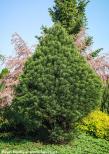Sequoiadendron giganteum 'GREENPEACE'

Sequoiadendron giganteum 'GREENPEACE'
Giant redwood, Sierra redwood, Giant sequoia
Giant redwood, Sierra redwood, Giant sequoia
| SIZE/TYPE | tall tree |
|---|---|
| USUAL HEIGHT | 20-40m |
| USUAL WIDTH | 5-10m |
| LEAVES | evergreen conifer |
| COLOUR OF LEAVES |
 green green |
| LOCATION | full sun |
| USDA zone (lowest) | 5 (down to -29°C) |
| WINTER PROTECTION | |
| FOR ZONE 5+6 |

|
| FOR ZONE 7 |

|
| BELONGS TO CATEGORIES |
Conifers Rarities |
Giant redwood or Sierra redwood, sometimes concisely called the Big tree is truly a big tree. In fact, the biggest in the world ever measured. It comes from Sierra Nevada mountains in east California, USA, and all synonyms describing its giant size are in place. There is even a Wikipedia list of the largest living giant sequoias. They were all given names and two at its top have reached worldwide fame: General Sherman and General Grant. General Sherman tree is located in the Giant Forest Grove of Sequoia National Park, California, and according to data from 1997 it was 83.8m tall and 2300-2700 years old. Its ‘little’ brother nearby General Grant was ‘only’ some 1650 years old and 81.7m tall. However, historically the biggest tree was even 15-20% taller and was cut down in 1940’s, its name was Crannell Creek Giant.
Greenpeace is a beautiful giant redwood variety of this evergreen conifer from the Netherlands. It is renowned for rich lawn-green to emerald green foliage which does not turn bronze in winter. Its habit is widely conical to pyramidal. If sufficiently insolated also at its bottom parts it keeps its lower branches for a long time, otherwise it loses them, revealing very attractive, reddish-brown, fissured, bark. Evergreen leaves are awl-shaped and pointed at the tips, and scale-like, and densely cover its thread-like twigs. Adult trees are noted for their great resistance to forest fires.
Giant redwood is a specimen tree for large gardens and parks. Even though it can take some pruning when young, I have seen pruned trees and they are ugly. Leave it to its own devices, forming a magnificent centrepiece of your landscape, admired by lovers of monumental features. It loves full sun and plenty of space – never use it in a mixed border. It does not mind low temperatures, however, it dislikes significant temperature swings, especially in late winter without snow. A good help is an extra watering during a frost free day before a freezing night.
It is easy to grow. In fact, once transplanted it does not need ANY maintenance at all apart from occasional watering during the first 1-2 years until it establishes. It will grow in most well-drained soil types. It makes thick roots which make the trunk stable during strong winds. Its hardiness is commonly suggested to -29°C (USDA zone 5), but is expected to be a little better if the soil is covered with snow.
Last update 20-02-2020
Greenpeace is a beautiful giant redwood variety of this evergreen conifer from the Netherlands. It is renowned for rich lawn-green to emerald green foliage which does not turn bronze in winter. Its habit is widely conical to pyramidal. If sufficiently insolated also at its bottom parts it keeps its lower branches for a long time, otherwise it loses them, revealing very attractive, reddish-brown, fissured, bark. Evergreen leaves are awl-shaped and pointed at the tips, and scale-like, and densely cover its thread-like twigs. Adult trees are noted for their great resistance to forest fires.
Giant redwood is a specimen tree for large gardens and parks. Even though it can take some pruning when young, I have seen pruned trees and they are ugly. Leave it to its own devices, forming a magnificent centrepiece of your landscape, admired by lovers of monumental features. It loves full sun and plenty of space – never use it in a mixed border. It does not mind low temperatures, however, it dislikes significant temperature swings, especially in late winter without snow. A good help is an extra watering during a frost free day before a freezing night.
It is easy to grow. In fact, once transplanted it does not need ANY maintenance at all apart from occasional watering during the first 1-2 years until it establishes. It will grow in most well-drained soil types. It makes thick roots which make the trunk stable during strong winds. Its hardiness is commonly suggested to -29°C (USDA zone 5), but is expected to be a little better if the soil is covered with snow.
Last update 20-02-2020
SIZES and PRICES
CURRENTLY SOLD OUT
GLOSSARY
|












